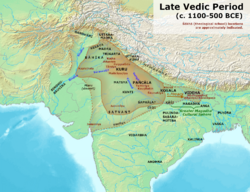Biology:Greater Magadha
Greater Magadha is a concept in studies of the early history of India.[1] It is used to refer to the political and cultural sphere that developed in the lower Gangetic plains (Johannes Bronkhorst defines the region to comprise modern day Bihar and eastern Uttar Pradesh) during the Vedic age.
The Śramaṇa culture of Greater Magadha developed parallel to but separate from the Vedic culture to its west,[3][4] that was characteristic of the upper Ganges basin (Ganga-Yamuna doab).
According to Bronkhorst, the sramana culture arose in "Greater Magadha," which was Indo-Aryan, but not Vedic. In this culture, Kshatriyas were placed higher than Brahmins, and it rejected Vedic authority and rituals.[1][5]
Overview
The concept was developed in a book by the indologist Johannes Bronkhorst (2007),[1] where he defines the region to comprise modern day Bihar and eastern Uttar Pradesh. They developed an ideological opposition to the sacrifice and ritual slaying of animals. Later this non-vedic traditions gave rise to religions or school of philosophy such as Jainism which later gave rise to concepts like ahimsa.[6]
According to Bronkhorst, the śramana culture arose in "Greater Magadha," which was Indo-Aryan, but not Vedic. In this culture, Kshatriyas were placed higher than Brahmins, and it rejected Vedic authority and rituals.[1][5]
Out of the ideological opposition between these two cultural spheres – the vedic realm of Kuru-Panchala in the west, and śramana of Greater Magadha in the east – developed the two main religious & spiritual ideologies of Ancient India.
Vedic religion, which placed a lot of importance on the system of ritual correctness, arose out of the culture of the erstwhile Kuru-Panchala realm, while the śramaṇa tradition, which placed emphasis on the spiritual works,[7] that developed in Greater Magadha, later to gave rise to non-vedic (non-brahmanical) religions such as Buddhism, Jainism, Ajivika, Lokāyata and Ajñana.
See also
- Magadha
- Vedic period
- Mahajanapadas
- History of India
References
- ↑ 1.0 1.1 1.2 1.3 1.4 Bronkhorst (2007).
- ↑ Samuel 2010.
- ↑ Olivelle, Patrick (1993). The āśrama system: the history and hermeneutics of a religious institution. New York. pp. 11–16. ISBN 978-0-19-534478-3. OCLC 496313855.
- ↑ Padmanabh S. Jaini, ed (2001). Collected papers on Buddhist studies. Delhi: Motilal Banarsidass Publishers. pp. 48. ISBN 81-208-1776-1. OCLC 47208728.
- ↑ 5.0 5.1 Long, Jeffery D (2009). Jainism. I.B. Tauris. doi:10.5040/9780755624966. ISBN 978-1-84511-625-5.
- ↑ Dundas, Paul (2002). The Jains (2nd ed.). London: Routledge. ISBN 0-203-39827-0. OCLC 252916273.
- ↑ {{cite book |chapter=Peace, Part Two: The Book of Liberation |title=Mahabharata Book Twelve |year=1988 |volume=3 |page=xlii |publisher=NYU Press |isbn=9780814794531 |chapter-url=https://books.google.com/books?id=BHQTCgAAQBAJ&dq=greater+magadha&pg=PR42 |via=Google Books
Sources
- Bronkhorst, Johannes (2007) (in en). Greater Magadha: Studies in the culture of early India. BRILL. ISBN 978-90-04-15719-4. OCLC 897004884. https://books.google.com/books?id=4GNG5KuH73QC&q=greater+magadha.
- Samuel, Geoffrey (2010), The Origins of Yoga and Tantra. Indic Religions to the Thirteenth Century, Cambridge University Press
 |


